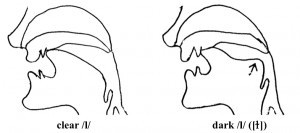Today’s tip is about unlocking the mystery of how and when to pronounce the dark English L sound.
Have you ever noticed that the /l/ in lock and the /l/ in felt and sell sound a bit different? The /l/ in lock is called the light /l/, and the /l/ in felt and sell is the English dark L sound. It sounds odd and not flowing if you make the light /l/ sound where you need a dark L sound.
Ok, so what’s the difference between the two ways of pronouncing the /l/ sounds in English? The /l/ is light if it comes before the vowel or diphthong in the syllable. If the /l/ comes after the vowel or diphthong in a syllable it is a dark L.
There isn’t a different letter or marking in English to denote the two types of L sounds. They are just both written as the letter /l/.
The light L in English Pronunciation
The light /l/ is the one most people know about and know how to produce. You make it by raising the tip of your tongue up, and touch the palate just behind your front top teeth. (the bony ridge on your palate behind your top front teeth). As you switch on your voice you push up a bit with the tip of your tongue. To be the light /l/ it has to occur before the vowel or diphthong, so it’s usually at the beginning of words. For example, long, loud, laugh, look, listen, land etc.
Pronouncing the English Dark L sound
The dark English /l/ sound is made up of two sounds. The first sound is a vowel sound like the ‘u’ /ʊ/ in the word ‘put’, and then the light /l/. The light /l/ is made very lightly.
Some examples of words with the dark English L sound are : always, fall, real, almost, called, felt, sell, bull etc. Let’s take the word ‘real’ and see how we do it. You need to move your tongue from the forward position for the ‘ee’ vowel, to the /ʊ/ sound ( as in ‘put’, and then lightly up to make the light /l/ sound. ‘ reeʊl’ As you make the /ʊ/ sound, the middle of your tongue goes up a bit before you just very lightly make the light /l/. (don’t hold the light /l/ on long, and don’t push up as hard as for the light /l/ at the beginning of words.)
Click on this link to have a listen to both the British and American productions with the English dark L. (The Australian is the same as the British for this purpose).
Another example is is the word ‘felt’. You need to move your tongue from the ‘e’ vowel position to the /ʊ/ sound and then to the light /l/ sound. ‘feʊlt’
Click on this link to listen to the British and American productions with the English dark L.
Of course when we say the words with the English dark L in sentences and connected speech, we don’t overdo putting the /ʊ/ in before the light /l/, but while you are practising you could over do it just slightly to get the idea.
Let me know how you go with this.
Best wishes,
Esther


